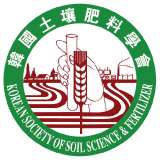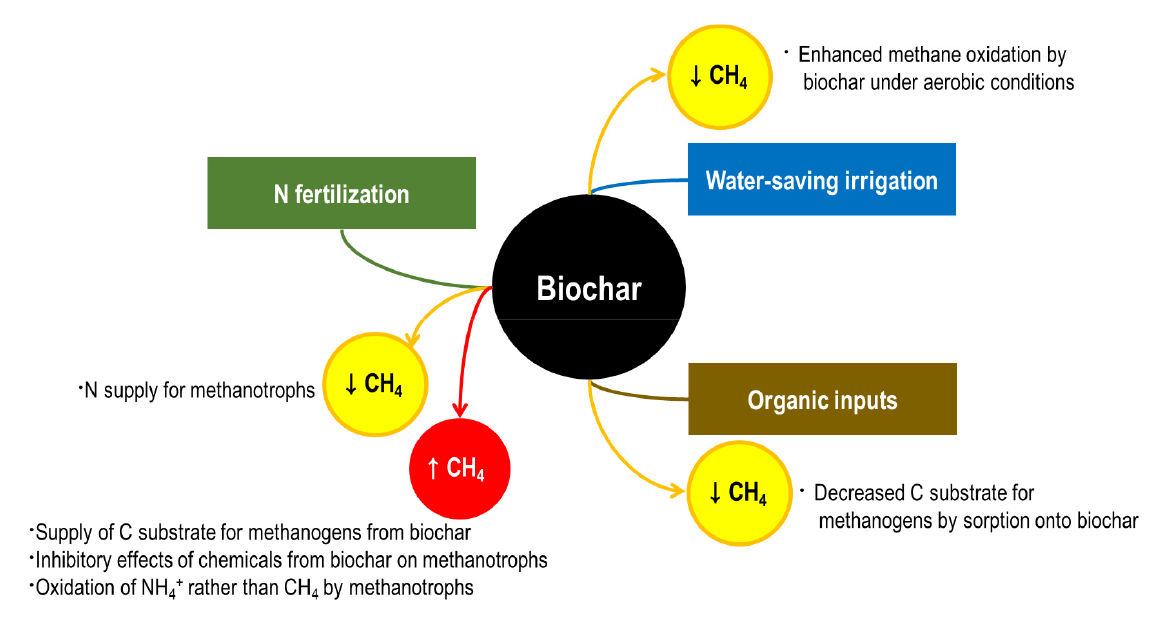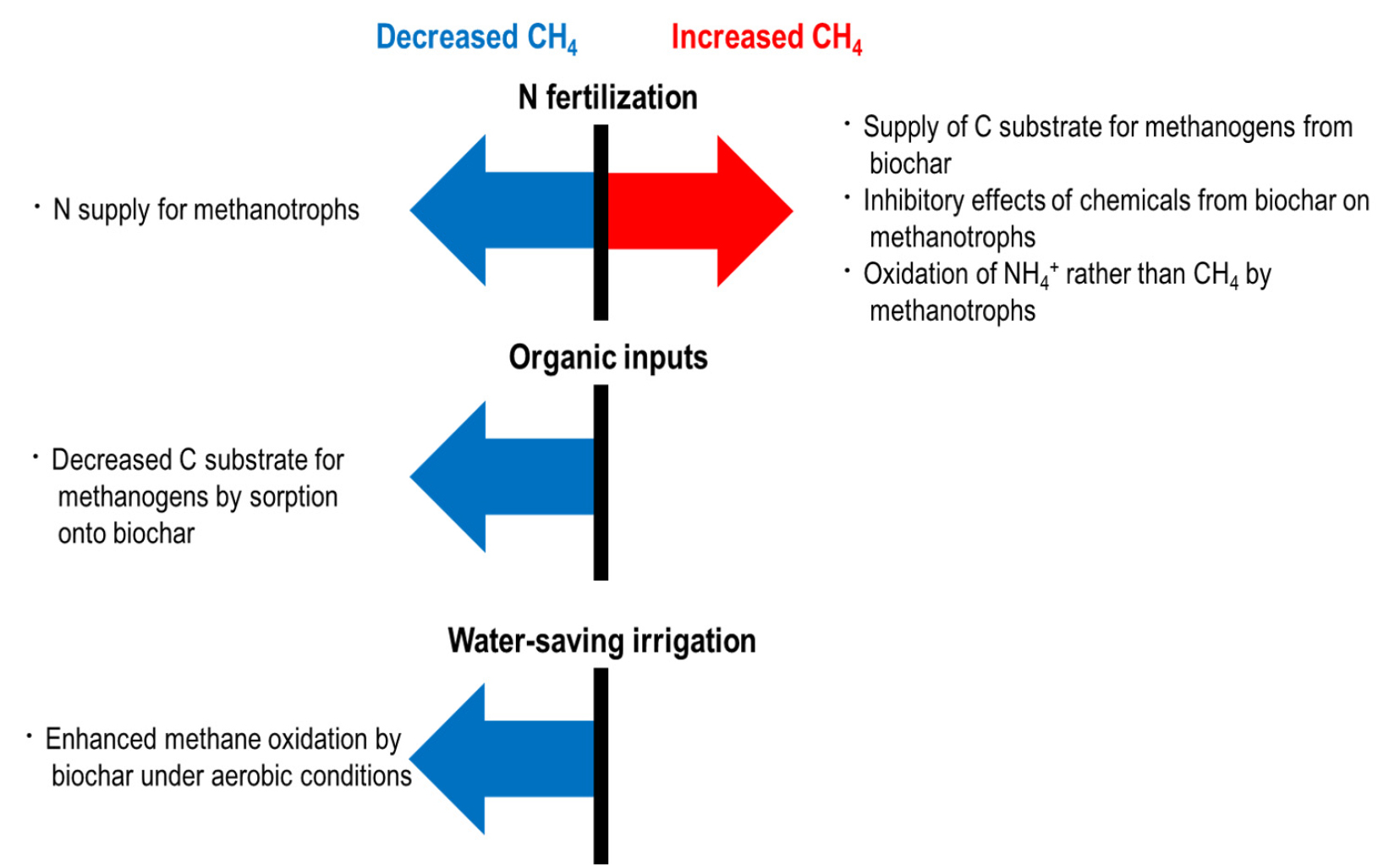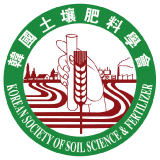Introduction
Literature Search and Data Analysis
N fertilization effects on the changes in CH4 emission by biochar
Organic Inputs Effects on the Changes in CH4 Emission by Biochar
Water Management Effects on the Changes in CH4 Emission by Biochar
Conclusions
Introduction
Biochar (BC) is known to effectively mitigate methane (CH4) emission from rice (Oryza sativa L.) paddies (Liu et al., 2011; Han et al., 2016; Nan et al., 2022). In a recent data analysis, Pia et al. (2024) reported that application of BC from various feedstocks decreased the area- and yield-scaled CH4 emission by 14.4% and 22.2%, respectively. The decreased CH4 emission by BC application is mediated by the changes in soil properties such as improved aeration in the rhizosphere (Dong et al., 2013), decreased organic substrate for methanogens (Han et al., 2016), increased soil pH favoring methanotrophs (Wang et al., 2019; Yi et al., 2019), and increased electron accepting powers of the soils (Zhang et al., 2019a, 2019b). These changes in soil properties eventually lead to increased abundances of methanotrophs over methanogens (Nan et al., 2021).
For precise utilization of BC for CH4 mitigation, several studies compared the efficiency of BC in reducing CH4 emission in terms of feedstock type, pyrolysis temperature, and BC application rates as summarized in Pia et al. (2024). It is understood that BC produced from lignocellulosic feedstock (rather than herbaceous feedstock) at higher temperature (rather than lower temperature) effectively mitigate CH4 emission due to stronger stability and more functional groups (Wang et al., 2015; Lee et al., 2023b). In terms of BC application rate, it has been suggested that annual BC application at a low rate (e.g. 2 t ha-1) is better than heavy application at once due to potential toxic compounds contained in BC and the aging of BC (Nan et al., 2020; Baek et al., 2024; Pia et al., 2024). However, the BC effects on CH4 emission are not consistent under different experimental conditions including fertilization rates, organic inputs, and water managements (Awad et al., 2018; Zhao et al., 2019; Yagi et al., 2020; Nan et al., 2021; Novair et al., 2023). Therefore, it is necessary to investigate the variations in the BC-induced changes in CH4 emission under different rice cultivation conditions for more precise utilization of BC for CH4 mitigation.
In this review, we investigated the changes in the BC performance on CH4 emission under different rice cultivation conditions such as nitrogen (N) fertilization rates, with or without organic inputs, and traditional vs. water-saving irrigation. We hypothesized that 1) BC performance on CH4 mitigation may be greater with increasing N fertilization rates as N is an essential element for methanotrophs, 2) co-application of BC with organic inputs may efficiently decrease CH4 emission by reducing substrate for methanogens via sorption onto BC compared to organic inputs without BC, and 3) application of BC may further decrease CH4 emission under water-saving irrigation by promoting CH4 oxidation under aerobic conditions.
Literature Search and Data Analysis
We collected as much as literature from the Web of Science and Google Scholar databases using the following keywords: TS = (“biochar”) and TS = (“paddy”) and TS = (“methane”) and TS = (“fertilization” or “organic” or “irrigation”). The number of publications was 17, 87, and 12 for fertilization, organic, and irrigation, respectively. Among those, 6, 3, and 3 publications that investigated BC effects on CH4 emission with N fertilization (e.g., without vs. with N fertilization at varying rates), organic inputs (e.g., without vs. with organic inputs), and irrigation methods (e.g., traditional flooding vs. water-saving irrigation), respectively were selected finally (Tables 1,2,3). We are aware of that the number of the publications is very limited due to lacking of relevant studies that investigated the effect of BC on CH4 emission with paired treatments. However, we believe the review may provide an insight into the rice cultivation practices to mitigate CH4 emission using BC in combination with other agricultural measures such as N fertilization, organic inputs, and water-saving irrigation.
The average CH4 emission data for each treatment were directly obtained from the tables and from the figures using GetData Graph Digitizer (version 2.26). The changes in the CH4 emission by BC were computed as a percentage difference from the control without BC application.
Table 1.
Summary of literature on the effects of biochar (BC) application on CH4 emission from paddy conditions under different N fertilization.
| References | Study types | Important findings |
| Iboko et al. (2023) | Literature review |
Co-application of BC at > 20 t ha-1 with N fertilization at 140 - 240 kg N ha-1 decreased CH4 by 82% while co-application of BC at ≤ 9 t ha-1 with N fertilization at ≤ 140 kg N ha-1 increased CH4 by 114% |
| Jeffery et al. (2016) | Meta-analysis |
Co-application of BC with N fertilizer at < 120 kg N ha-1 decreased CH4 emission while it did not affect CH4 emission with N fertilizer at > 120 kg N ha-1 |
| Kim et al. (2017) | Field experiment |
Co-application of BC at 2 t ha-1 decreased CH4 emission from paddy fertilized with urea (90 kg N ha-1) by 34% and with slow-release fertilizer (45 kg N ha-1) by 36% |
| Shaukat et al. (2019) | Pot experiment |
Co-application BC at 2 and 4% with N fertilizer (70 and 140 kg N ha-1) increased CH4 emission by 32 - 63% |
| Sui et al. (2016) | Field experiment |
BC application (1.78, 14.8, and 29.6 t ha-1) increased CH4 emission under no N fertilization by 10.2 - 55.8% but decreased CH4 emission by 13.5 - 138.7% with N fertilization |
| Zhang et al. (2010) | Field experiment |
Co-application of BC at 10 t ha-1 did not change CH4 emission but BC application at 40 t ha-1 increased CH4 emission by 54% under N fertilization |
Table 2.
Summary of literature on the effects of biochar (BC) application on CH4 emission from paddy conditions under organic inputs.
| References | Study types | Important findings |
| Cai et al. (2018) |
Incubation experiment |
Co-application of BC with rice straw decreased CH4 by 23.5 - 50.8% compared to rice straw alone |
| Kang et al. (2021) | Field experiment |
Co-application of barley straw BC (10 t ha-1) with raw barley straw (10 t ha-1) decreased CH4 emission by 33% compared to the barley straw alone treatment (20 t ha-1) |
| Wang et al. (2018) | Pot experiment |
Application of rice straw at 15 t ha-1 increased CH4 emission by 675% but this increment was reduced to 250% by the application of maize straw BC at 45 t ha-1 compared to rice straw application at 7.5 t ha-1 |
Table 3.
Summary of literature on the effects of biochar (BC) application on CH4 emission from paddy conditions under different water management.
| References | Study types | Important findings |
| Jeffery et al. (2016) | Meta-analysis |
Application of BC deceased CH4 emission from flooded paddy while increasing CH4 emission from upland |
| Sriphirom et al. (2019) | Field experiment |
Mangrove BC application (10 t ha-1) additively decreased CH4 emission from paddies under alternate wetting-drying |
| Yang et al. (2019) | Field experiment |
Application of BC decreased CH4 emission under controlled irrigation by 16% but increased CH4 emission under continuous flooding |
N fertilization effects on the changes in CH4 emission by biochar
The effects of N fertilization on BC-induced changes in CH4 emission were not consistent, but there were evidences on the enhanced decreases in CH4 emission by BC under N fertilization (Fig. 1) because N is an essential element for methanotrophs particularly in N-poor soils (Bodelier and Laanbroek, 2004). For example, Iboko et al. (2023) analyzed the effects of different rates of BC on CH4 mitigation under varying N fertilization rates through literature analysis. In the study of Iboko et al. (2023), application rates of BC were grouped into low (≤ 9 t ha-1), medium (> 9 and ≤ 20 t ha-1), and high (> 20 t ha-1) while N fertilization rates were classified into low (≤ 140 kg N ha-1), medium (> 140 and ≤ 240 kg N ha-1), and high (> 240 kg N ha-1). They found that compared to N fertilization alone, co-application of BC at a high rate with medium N rates decreased CH4 emission by 82%. In comparison, co-application of BC at a low rate with low N rates increased CH4 emission by 114%. Increased CH4 emission after low N application has been reported regardless of BC co-application because of N limitation for methanotrophs (Bodelier and Laanbroek, 2004; Banger et al., 2012; Shaukat et al., 2019). Sun et al. (2016) also reported that N application at < 100 kg N ha-1 stimulated CH4 emission while N application at > 200 kg N ha-1 inhibited CH4 emission. In a study to investigate the effects of BC from rice straw (1.78, 14.8, and 29.6 t ha-1) on CH4 emissions from paddy without or with N fertilization (210 kg N ha-1), Sui et al. (2016) also found that BC increased CH4 emission under no N fertilization by 10.2 - 55.8% but decreased CH4 emission by 13.5 - 138.7% with N fertilization, suggesting that CH4 mitigation by BC is dependent on N fertilization rates.
In a pot experiment using nine treatment combinations of BC (0, 2, and 4%) and N fertilization (0, 70, and 140 kg N ha-1), however, Shaukat et al. (2019) found that BC application increased CH4 emission relative to no BC treatment at a given N fertilization rate. Specifically, BC application at 2 and 4% increased CH4 emission by 136% and 156%, 51% and 63%, and 38% and 32% for 0, 70, and 140 kg N ha-1, respectively. The increased CH4 emissions by BC application were attributed to supply of C substrate for methanogens (Gaihre et al., 2011) and releases of inhibitory chemicals for methanotrophs from BC (Spokas et al., 2010; Pia et al., 2024). Despite the stimulative effects of BC on CH4 emission in the study of Shaukat et al. (2019), however, the increment of CH4 emission by BC decreased with increasing N fertilization rates, suggesting that co-application of BC and N fertilizer reduce CH4 emission from soils amended with BC alone through supply of N, which is an essential element for methanotrophs (Bodelier and Laanbroek, 2004). Therefore, the study of Shaukat et al. (2019) implies that the possible BC-induced increases in CH4 emission can be alleviated by N fertilization. In contrast, Zhang et al. (2010) reported that CH4 emission marginally changed by N fertilization, and BC application (10 and 40 t ha-1) increased CH4 emission in soils without N fertilization by 65 - 68%. However, with N fertilization (300 kg N ha-1), co-application of BC at 10 t ha-1 did not change CH4 emission, but BC application at 40 t ha-1 increased CH4 emission by 54%.
The decreased CH4 emission from N-fertilized soils by BC is often related to the beneficial effects of N on methanotrophs (Bodelier and Laanbroek, 2004). However, high N application may also reduce CH4 emission by decreasing root biomass and activity releasing C substrate for CH4 production within rhizospheres as roots do not have to grow extensively to explore N under high N availability (Chen et al., 2018). In contrast, it has also been reported that a high N application may increase CH4 emission by inhibiting CH4 oxidation under a high NH4+ concentration as methanotrophs uses NH4+ instead of CH4 for energy sources while using O2 as an electron acceptor (Adviento-Borbe and Linquist, 2016). It has also been suggested that unless N availability for methanotrophs is not limited, a high N fertilization increase CH4 emission via decreased CH4 oxidation through competitive exclusion of CH4 at binding sites of methanotrophs by NH4+ (Hu and Lu, 2015; Yang et al., 2020).
Despite the inconsistency of N fertilization effects on BC-induced mitigation of CH4, in a meta-analysis study of Jeffery et al. (2016), it was reported that co-application of BC with N fertilizer at < 120 kg N ha-1 decreased CH4 emission while it did not affect CH4 emission with N fertilizer at > 120 kg N ha-1. The threshold N fertilization for switch between stimulation and inhibition of CH4 oxidation has been reported to be 100 - 140 kg N ha-1 (Aronson and Hellilker, 2010; Banger et al., 2012). In this context, the standard N fertilization rate for rice of Korea (90 kg N ha-1) may be suitable for CH4 mitigation by BC application. In Korea, a study also indicated that the effects of BC on CH4 mitigation did not differ between the standard N fertilization and reduced N fertilization using a slow-release fertilizer (Kim et al., 2017). In the study of Kim et al. (2017), it was found that co-application of rice husk BC at 2 t ha-1 decreased CH4 emission from paddy fertilized with urea (90 kg N ha-1) by 34% and with a slow-release fertilizer (45 kg N ha-1) by 36%.
Organic Inputs Effects on the Changes in CH4 Emission by Biochar
The application of organic inputs such as crop residues is recommended for sustainable rice production by improving soil health (Wei et al., 2021; Lee et al., 2023a). However, the benefits of using organic inputs may be hampered by the potential increases in CH4 emissions (Song et al., 2024). Therefore, it is highly necessary to explore agricultural management to mitigate CH4 emission from organic-amended paddies. Three studies (Cai et al., 2018; Wang et al., 2018; Kang et al., 2021) consistently indicated that BC efficiently decreased CH4 emissions across the experimental regimes from a lab incubation to a field experiment (Fig. 1). In an incubation experiment, Cai et al. (2018) reported that with increased application of rice straw from 1% to 2% (w/w), CH4 emission increased by 59.6%; however, co-application of rice straw BC (1%, w/w) pyrolyzed at 300°C and 700°C decreased CH4 emission by 23.5% and 50.8% for the treatments with rice straw at 1%, respectively. Cai et al. (2018) attributed the CH4 mitigation by BC to decreased concentration of dissolved organic carbon (DOC), which is the substrate for methanogens, by sorption of DOC on to BC surfaces (Kasozi et al., 2010; Mukherjee and Zimmerman, 2013).
In Korea, Kang et al. (2021) reported that application of barley straw alone (20 t ha-1) 14 days before rice transplanting did not increase CH4 emission and co-application of BC pyrolyzed from barley straw (10 t ha-1) with raw straw (10 t ha-1) decreased CH4 emission by 33% compared to the barley straw alone treatment (10 t ha-1). Similarly, Wang et al. (2018) reported that a high application of rice straw (15 t ha-1) increased CH4 emission by 675% compared to that with rice straw at 7.5 t ha-1, but this increment was reduced to 250% by the application of maize straw BC at 45 t ha-1. Therefore, these results suggest that co-application of BC with organic inputs may be a feasible measure to reduce CH4 emission from organic-amended paddy soils.
Water Management Effects on the Changes in CH4 Emission by Biochar
All literature studied in this review showed that BC enhances CH4 mitigation under water saving irrigation (Table 3 and Fig. 1). In a meta-analysis study, Jeffery et al. (2016) reported that BC decreased CH4 emission from flooded paddy while increasing CH4 emission from upland and unchanging CH4 emission under flooding-drying cycles. However, Yang et al. (2019), who compared the effects of rice straw BC (40 t ha-1) on CH4 emissions between controlled irrigation (flooding only in regreening stage) and continuous flooding except for ripening stage, reported that BC application decreased CH4 emission by 16% in controlled irrigation treatment but increased CH4 emission by 60% under continuous flooding, suggesting that CH4 oxidation under controlled irrigation was enhanced by BC application while BC promotes CH4 emission in flooded paddies.
In Thailand, Sriphirom et al. (2019) investigated the effects of the application of Mangrove (Rhizophora apiculata) biochar at 10 t ha-1 on CH4 emission from chemically fertilized paddy (90 kg N ha-1) under different water regimes, continuous flooding vs. alternate wetting and drying (AWD). They found that BC decreased CH4 emission by 12% under both continuous flooding and AWD conditions because BC enhanced the sink capacity of CH4 in soil by increasing the growth of methanotrophs and decreasing the abundance ratio of methanogenic archaea to methanotrophic bacteria. As AWD alone also decreased CH4emission by 12% regardless of BC application due to shortened duration of anaerobic condition, BC application combined with AWD reduced CH4 emission by 24% when compared to no BC application under continuous flooding. This result suggests that combined BC application and AWD effects on CH4 emission is additive. Despite the potential increases in CH4 emission by BC application under continuous flooding (Yang et al., 2019), middle-season drainage is common practice in Korea, and thus BC application may help CH4 mitigation during the course of the drainage. Besides, BC may further help rice growth during AWD via soil water and nutrient retention during soil drying because of the high water and nutrient sorption capacity of BC (Haque et al., 2021).
Conclusions
Mitigation of CH4 from rice paddy soils with the application of BC is well understood. However, the relevant studies have been conducted under fixed rice cultivation conditions; e.g., at a single dose of N fertilization, without organic inputs, and under traditional irrigation conditions. The present study shows that the direction or magnitude of changes in CH4 emission by BC is subject to these rice cultivation conditions. Co-application of BC with N fertilizer may increase or decrease CH4 emission compared to the N fertilization alone depending on the N fertilization rates. Although the threshold N fertilization for the turnover of increase or decrease of CH4 emission is still unclear, N fertilization may enhance CH4 oxidation mediated by BC via the supply of N to methanotrophs. In contrast, there is a caution that co-application of BC with N fertilizer may increase CH4 emission through the supply of C substrate to methanogens, inhibitory effects of toxic chemicals on methanotrophs, and preferential oxidation of NH4+ to CH4 by methanotrophs. Under organic inputs such as straw addition, BC may efficiently decrease CH4 emission by reducing C substrate availability for methanogens via sorption. The application of BC combined with water-saving irrigation may additively enhance CH4 mitigation by promoting CH4 oxidation under aerobic conditions. Therefore, our study suggests that application of BC may be a measure to mitigate CH4emission from paddy soils amended with organic inputs and to enhance CH4 oxidation under water-saving irrigation including AWD and extended or multiple middle-season drainage.






